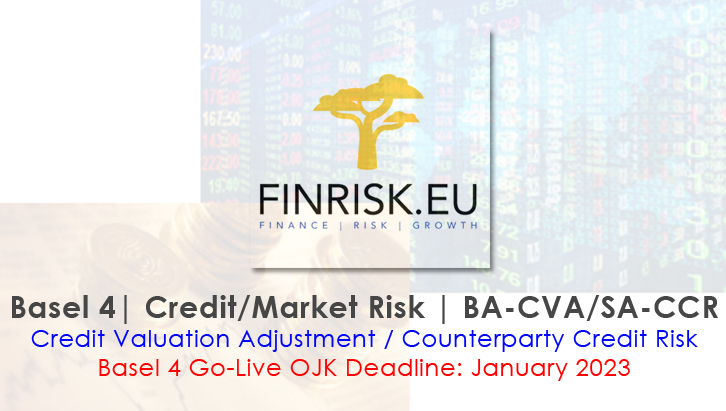
| Delivery Language | Duration | Fee |
|---|---|---|
| Bahasa Indonesia | 1 day | 5mio IDR |
Summary
This training will teach participants over the Credit Valuation Adjustment (CVA), which is initially introduced in Basel 3 (Regulatory CVA) and part of IFRS 13 (Accounting CVA). The CVA standards have been live now by BIS (Bank for International Settlement) for several years with some revisions have taken place, in which OJK (Otoritas Jasa Keuangan) also has published CP (Consultative Paper) for this topic in OJK’s Basel adaptation website, referring to the BIS 2017 CVA framework. In this 1-day training, participants will be introduced to the important building blocks and key points of CVA under the Basic Approach (BA-CVA), which is the standards adopted by OJK, along with explanations over the CVA capital formula building blocks.
Why should your team join this training?
- OJK still committed to the Basel 4 implementation on January 2023 (https://bit.ly/35I5O9M), in which this includes CVA risk as part of risk-weighted asset calculation (ATMR). Understanding the difference between Accounting CVA and Regulatory CVA is very important in relation to the implementation.
- The quantitative aspect of CVA is one of the challenging topics in Basel 4 due to its highly quantitative formulation as a hybrid subject between market risk and credit risk, despite the simplification attempt done in BA-CVA. The standards also related to SA-CCR framework, in which important points of this framework will also be explained in this training
- CVA implementation in Europe has been maturing along with other valuation adjustments (XVA) in these last years, in which the trainer has hands-on knowledge on XVA projects, systems, and reporting.
This training will be brought by expert who has extensive (10+ years) experience in European banking sectors, with stakeholders from various level and domains, e.g. trading and quants, to give training audience perspectives from multiple dimension within a bank.
OJK’s related CP:
Basel’s original document:
CVA: https://www.bis.org/bcbs/publ/d424.pdf
SA-CCR: https://www.bis.org/publ/bcbs279.pdf
Suitable For
- Junior (0-4 years of experience)
- Mid-level (5-10 years of experience)
This training is eligible for CPD (Continuing Professional Development) credits of certifications (e.g. FRM) issued by GARP (Global Association of Risk Professionals)
Keywords
basel, basel 4, basel 3, OJK, market risk, credit risk, cva, credit valuation adjustment, cva, xva, risk management, banking, regulations, legal, law, compliance, ccr, counterparty credit risk, derivatives, garp cpd
Syllabus
Basel IV / BA-CVA Overview
In this overview, training audience will be presented with the motivation and building blocks of Credit Valuation Adjustment (CVA). On top-level, CVA calculation consists of following important components: PD (probability of default), LGD (loss-given default), EAD (exposure at default), and hedging activities. Comparison between Accounting CVA (IFRS 13) and Regulatory CVA (Basic Approach, Basel 4) will also be presented in this module
PD: Probability of Default & LGD: Loss-Given Default (BA-CVA)
PD & LGD reflects the credit risk aspect of CVA calculation. This module is to explain how BA-CVA defined PD & LGD by entity sector/credit quality matrix, and how it is compared to accounting CVA definition
EAD: Exposure at Default (SA-CCR)
This module will discuss the market risk dimension of CVA calculation, where BA-CVA referred to EAD definition under SA-CCR framework. Comparison to EAD calculation under accounting CVA will also be explained here
CVA Hedging
There are multiple ways to reduce CVA capital by means of hedging. This module will explain these methods along with challenges
XVA: Next Level Valuation Adjustments
Globally, trading participants are now not only calculation CVA, but also other types of valuation adjustments (XVA) as IFRS 13 accounting standards require. This module is to discuss what are the latest development on XVA practices and infrastructure challenges it poses
Brochure
